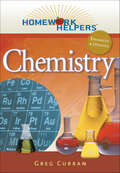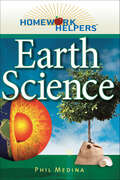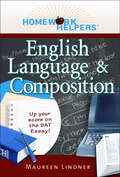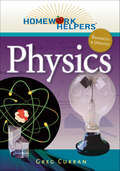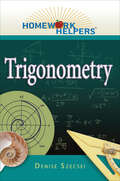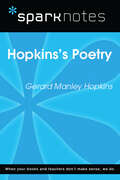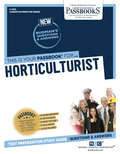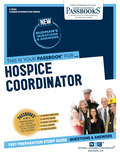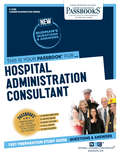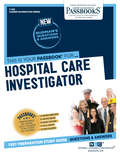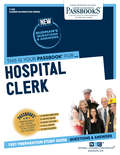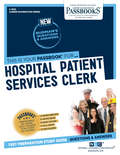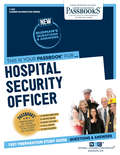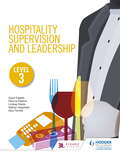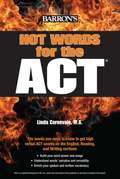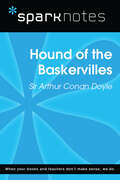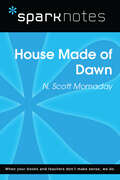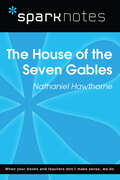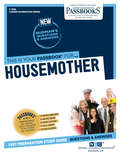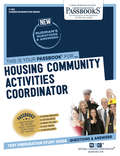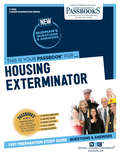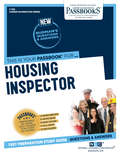- Table View
- List View
Homework Helpers: Chemistry (Homework Helpers)
by Greg CurranHomework Helpers: Chemistry is a user-friendly review book that will make every student—or parent trying to help their child feel like he or she has a private Chemistry tutor. Concepts are explained in clear, easy-to-understand language, and problems are worked out with step-by-step methods that are easy to follow. Each lesson comes with numerous review questions and answer keynotes that explain each correct answer and why it’s correct.This book covers all of the topics in a typical one-year Chemistry curriculum, including:A systematic approach to problem solving, conversions, and the use of units.Naming compounds, writing formulas, and balancing chemical equations.Gas laws, chemical kinetics, acids and bases, electrochemistry, and more.While Homework Helpers: Chemistryis an excellent review for any standardized Chemistry test, including the SAT-II, its real value is in providing support and guidance during the year’s entire course of study.
Homework Helpers: Earth Science (Homework Helpers)
by Phil MedinaHomework Helpers: Earth Science covers all of the topics typically included in a high school or undergraduate course, including:•How to understand "the language of rocks."•The events that we see in the sky and how they affect us.•Earthquakes and what they can tell us about the inside workings of our world.•How to understand the weather and what the weatherman is saying.Homework Helpers: Earth Science is loaded with practical examples using everyday experiences. Every topic includes a number of simple tricks to make even the toughest ideas understandable and memorable. Each chapter ends with practice questions and explanations of answers. As a reference tool Homework Helpers: Earth Science can be used as a preview of tomorrow--s class or a reinforcement of today--s. It will leave students with a firm grasp of the material and the confidence that will inspire a deeper understanding.
Homework Helpers: English Language & Composition (Homework Helpers)
by Maureen LindnerEssential preparation for the new SAT Writing and Grammar Section. Homework Helpers: English Language & Composition is a user-friendly review book that will make any student—or those trying to help them—feel like he or she has a private tutor. Each chapter includes detailed questions that allow students to assess how well they've mastered each idea. Not only does the author provide the right answers to these self-study questions, but also detailed explanations of why the wrong answers are wrong. When is a comma used? Why are some titles capitalized? How are dangling modifiers prevented? There are hundreds of grammatical and compositional rules, many of them difficult to understand and memorize. And just as many exceptions to the rules! Homework Helpers: English Language and Composition focuses on all aspects of writing, with clear lessons and exercises on:• Parts of speech• Punctuation• Tone• The writing process• Types of sentences• Types of essays• Revisions• Common errors to avoid Students from high school through college will find this book to be an essential writing tool. Younger students can follow the lessons from beginning to end to learn everything they need to know about language and composition. The more experienced student can pick and choose lessons and exercises according to need—especially if they're facing the new SAT. The Homework Helpers Series is just what students need to boost their confidence and give them the help they need to ace even the most challenging classes and tests.
Homework Helpers: Physics (Homework Helpers)
by Greg CurranHomework Helpers: Physics is the latest book in the popular series that has been designed to help students master the material and tackle the tests. It will help any student unravel the formulas that describe the world around him or her. Each lesson is written in clear, easy-to-understand language, and supported with review questions. Answers and detailed explanations are found at the end of each chapter.Homework Helpers: Physics covers all of the topics included in a typical one-year physics curriculum, including:Straight-line kinematics, free-fall, and projectile motion.Forces, friction, and motion on an incline.Electrostatics, electricity, and magnetism.Waves, light, and optics.Nuclear reactions.The Homework Helpers Series is an excellent review for any standardized Physics test, and is invaluable in providing support and guidance throughout a year’s course of study.
Homework Helpers: Pre-Calculus (Homework Helpers)
by Denise SzecseiThis title in the Homework Helpers series will reinforce mathematical foundations and bolster students' confidence in pre-calculus. The concepts are explained in everyday language before the examples are worked. Good habits, such as checking your answers after every problem, are reinforced.There are practice problems throughout the book, and the answers to all of the practice problems are included. The problems are solved clearly and systematically, with step-by-step instructions provided.Particular attention is placed on topics that students traditionally struggle with the most. While this book could be used to supplement a standard pre-calculus textbook, it could also be used by college students or adult learners to refresh long-forgotten concepts and skills.Homework Helpers: Pre-Calculus is a straightforward and understandable introduction to differential calculus and its applications. It covers all of the topics in a typical Calculus class, including:•Linear functions•Polynomials•Rational functions•Exponential functions•Logarithmic functions•Systems of equationsThis book also contains a review of the pre-calculus concepts that form the foundation on which calculus is built.
Homework Helpers: Trigonometry (Homework Helpers)
by Denise SzecseiThe essential help you need when your trigonometry textbook just isn’t making the grade!Trigonometry includes concepts that have both a geometric and an algebraic component. Homework Helpers: Trigonometry covers all of the topics in a typical trigonometry class, including:The unit circleTrigonometric functionsInverse trigonometric functionsIdentitiesGraphical analysisApplicationsThis book also contains a review of the algebraic and geometric ideas that are the foundation of trigonometry. Let a longtime teacher with a PhD in mathematics give you the boost you need to pass the class, prepare for an AP course, or just strengthen your skills.
Hopkins's Poetry (SparkNotes Literature Guide Series)
by SparkNotesHopkins's Poetry (SparkNotes Literature Guide) by Gerald Manley Hopkins Making the reading experience fun! Created by Harvard students for students everywhere, SparkNotes is a new breed of study guide: smarter, better, faster.Geared to what today's students need to know, SparkNotes provides:chapter-by-chapter analysis explanations of key themes, motifs, and symbols a review quiz and essay topics Lively and accessible, these guides are perfect for late-night studying and writing papers.
Horticulturist: Passbooks Study Guide (Career Examination Series)
by National Learning CorporationThe Horticulturist Passbook® prepares you for your test by allowing you to take practice exams in the subjects you need to study. It provides hundreds of questions and answers in the areas that will likely be covered on your upcoming exam, including but not limited to: principles and practices of horticulture; plant care and maintenance; plant diseases and pests; supervision; and other related areas.
Hospice Coordinator: Passbooks Study Guide (Career Examination Series)
by National Learning CorporationThe Hospice Coordinator Passbook® prepares you for your test by allowing you to take practice exams in the subjects you need to study. It provides hundreds of questions and answers in the areas that will likely be covered on your upcoming exam.
Hospital Administration Consultant: Passbooks Study Guide (Career Examination Series)
by National Learning CorporationThe Hospital Administration Consultant Passbook® prepares you for your test by allowing you to take practice exams in the subjects you need to study. It provides hundreds of questions and answers in the areas that will likely be covered on your upcoming exam.
Hospital Care Investigator: Passbooks Study Guide (Career Examination Series #C-326)
by National Learning CorporationThe Hospital Care Investigator Passbook® prepares you for your test by allowing you to take practice exams in the subjects you need to study. It provides hundreds of questions and answers in the areas that will likely be covered on your upcoming exam, including but not limited to; Supervisory problems and techniques; Techniques of interviewing and investigation; Staff development; Preparation of records and reports; and more.
Hospital Clerk: Passbooks Study Guide (Career Examination Series #C-328)
by National Learning CorporationThe Hospital Clerk Passbook® prepares you for your test by allowing you to take practice exams in the subjects you need to study. It provides hundreds of questions and answers in the areas that will likely be covered on your upcoming exam, including but not limited to: clerical operations with letters and numbers; medical terminology; name and number checking; office record keeping; understanding and interpreting written material; and other related areas.
Hospital Patient Services Clerk: Passbooks Study Guide (Career Examination Series)
by National Learning CorporationThe Hospital Patient Services Clerk Passbook® prepares you for your test by allowing you to take practice exams in the subjects you need to study. It provides hundreds of questions and answers in the areas that will likely be covered on your upcoming exam, including but not limited to; Filing; Name and number checking; Spelling in a health care setting; Supervision; and more.
Hospital Security Officer: Passbooks Study Guide (Career Examination Series #C-353)
by National Learning CorporationThe Hospital Security Officer Passbook® prepares you for your test by allowing you to take practice exams in the subjects you need to study. It provides hundreds of questions and answers in the areas that will likely be covered on your upcoming exam.
Hospitality Supervision and Leadership Level 3
by Patricia Paskins Ketharanathan Vasanthan Gary FarrellyPrepare for assessment and master the skills and knowledge you need to succeed as a hospitality and catering supervisor with this support resource. Covering all of the latest mandatory and most popular optional units, with a strong focus on preparation for assessment, this will be an essential resource for anyone working towards the Level 3 NVQ Diploma in Hospitality Supervision and Leadership, whether in college or in the workplace. It also provides support for those completing the Hospitality Supervision and Leadership apprenticeship. - Provides all of the essential knowledge and skills any supervisor working in the hospitality industry will need: from supporting, motivating and developing staff, to customer service skills, problem solving and controlling resources - Develops understanding of the assessment requirements with clear explanations of all criteria - Helps you to build your portfolio, with guidance on suitable evidence and activities that provide assessment opportunities - Prepares you for professional discussions and questioning with knowledge checks at the end of each unit to test your understanding
Hospitality Supervision and Leadership Level 3
by Patricia Paskins Ketharanathan Vasanthan Gary Farrelly Lindsay Steele Professor David FoskettPrepare for assessment and master the skills and knowledge you need to succeed as a hospitality and catering supervisor with this support resourceCovering all of the latest mandatory and most popular optional units, with a strong focus on preparation for assessment, this will be an essential resource for anyone working towards the Level 3 NVQ Diploma in Hospitality Supervision and Leadership, whether in college or in the workplace. It also provides support for those completing the Hospitality Supervision and Leadership apprenticeship.- Provides all of the essential knowledge and skills any supervisor working in the hospitality industry will need: from supporting, motivating and developing staff, to customer service skills, problem solving and controlling resources- Develops understanding of the assessment requirements with clear explanations of all criteria- Helps you to build your portfolio, with guidance on suitable evidence and activities that provide assessment opportunities- Prepares you for professional discussions and questioning with knowledge checks at the end of each unit to test your understanding
Hot Words for the ACT
by Linda Carnevale M.A.This helpful book for college-bound students presents and defines more than 250 words that appear in the verbal portions of the ACT exam. Also included are real test taker’s anecdotes, memory tips, review exercises, and an alphabetical word index. Lessons provide numerous illustrative sentences using vocabulary relevant to the ACT English, Reading, and Writing tests. College-bound students who successfully complete the book’s exercises and master these words will expand their lifelong vocabulary, enrich their essay writing and speaking, and improve their chances for acceptance at the colleges of their choice.
Hound of the Baskervilles (SparkNotes Literature Guide Series)
by SparkNotesHound of the Baskervilles (SparkNotes Literature Guide) by Sir Arthur Conan Doyle Making the reading experience fun! Created by Harvard students for students everywhere, SparkNotes is a new breed of study guide: smarter, better, faster.Geared to what today's students need to know, SparkNotes provides:chapter-by-chapter analysis explanations of key themes, motifs, and symbols a review quiz and essay topics Lively and accessible, these guides are perfect for late-night studying and writing papers.
House Made of Dawn (SparkNotes Literature Guide Series)
by SparkNotesHouse Made of Dawn (SparkNotes Literature Guide) by N. Scott Momaday Making the reading experience fun! Created by Harvard students for students everywhere, SparkNotes is a new breed of study guide: smarter, better, faster.Geared to what today's students need to know, SparkNotes provides:chapter-by-chapter analysis explanations of key themes, motifs, and symbols a review quiz and essay topics Lively and accessible, these guides are perfect for late-night studying and writing papers.
House of Seven Gables (SparkNotes Literature Guide Series)
by SparkNotesHouse of Seven Gables (SparkNotes Literature Guide) by Nathaniel Hawthorne Making the reading experience fun! Created by Harvard students for students everywhere, SparkNotes is a new breed of study guide: smarter, better, faster.Geared to what today's students need to know, SparkNotes provides:chapter-by-chapter analysis explanations of key themes, motifs, and symbols a review quiz and essay topics Lively and accessible, these guides are perfect for late-night studying and writing papers.
Housemother: Passbooks Study Guide (Career Examination Series)
by National Learning CorporationThe Housemother Passbook® prepares you for your test by allowing you to take practice exams in the subjects you need to study. It provides hundreds of questions and answers in the areas that will likely be covered on your upcoming exam, including but not limited to: food service, cooking and nutrition; clothing; furniture and decorating; and more.
Housing Community Activities Coordinator: Passbooks Study Guide (Career Examination Series)
by National Learning CorporationThe Housing Community Activities Coordinator Passbook® prepares you for your test by allowing you to take practice exams in the subjects you need to study. It provides hundreds of questions and answers in the areas that will likely be covered on your upcoming exam.
Housing Consumer Representative: Passbooks Study Guide (Career Examination Series)
by National Learning CorporationThe Housing Consumer Representative Passbook® prepares you for your test by allowing you to take practice exams in the subjects you need to study. It provides hundreds of questions and answers in the areas that will likely be covered on your upcoming exam, including but not limited to: Locating and verifying information about programs and policies; Responding to requests for information; Providing information to the media and the public in an appropriate and timely manner; and more.
Housing Exterminator: Passbooks Study Guide (Career Examination Series)
by National Learning CorporationThe Housing Exterminator Passbook® prepares you for your test by allowing you to take practice exams in the subjects you need to study. It provides hundreds of questions and answers in the areas that will likely be covered on your upcoming exam, including but not limited to: reading; following instructions; performing arithmetic computations; safety precautions; and more.
Housing Inspector: Passbooks Study Guide (Career Examination Series #C-1426)
by National Learning CorporationThe Housing Inspector Passbook® prepares you for your test by allowing you to take practice exams in the subjects you need to study. It provides hundreds of questions and answers in the areas that will likely be covered on your upcoming exam, including but not limited to: building mechanical systems (such as plumbing, heating and ventilation) and other parts of dwellings, such as windows, doors, and public access areas; various building materials used in construction and completion of residences and multiple-dwellings, and related trade practices (such as carpentry, plumbing, and plastering); comprehension and interpretation of housing laws, rules, and regulations, and related agency directives; reading building plans; and more.
